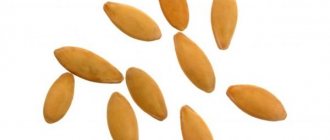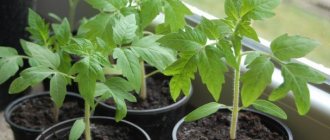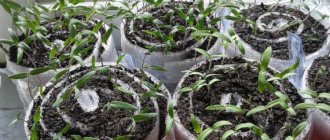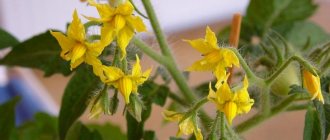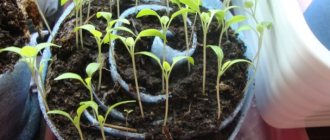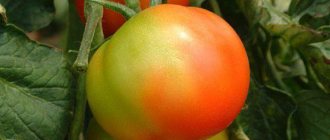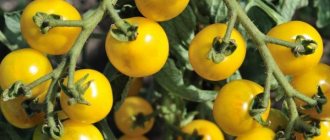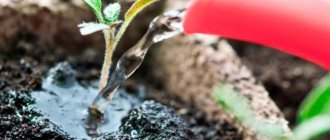Timing for sowing tomato seeds for seedlings
Planning the dates when the sprouts will be transplanted into open ground will help you figure out when it’s best to sow tomato seeds for seedlings. Growing tomato seedlings takes no more than a couple of months. You need to wait until the first true leaves appear.
The weather conditions of the region influence the transplantation of shoots into the ground:
- In the southern regions, warm weather is pleasant already in March. It turns out that grains can be sown without fear at the end of January or February.
- In the north, frosts give way to warmth at the end of May. Therefore, tomato seeds are prepared for sowing in early April.
It doesn’t hurt to look at the favorable days for sowing planting material for seedlings in the lunar calendar.
It has been proven that during the waxing moon, vegetable crops experience rapid sap flow.
If you sow seeds for seedlings these days, shoots will appear in a few days. On the full moon, the fruits fill with juice and smell delicious. During this phase, it will not hurt to harvest, but it is better to avoid trimming the leaves.
When to water tomato seedlings for the first time: video
After the dive
Rooted seedlings can be watered through a tray or using a watering can without a nozzle. When watering through a tray, the roots strive for moisture and grow faster. Using a watering can, pour water until it reaches the bottom of the container. When water slowly penetrates into the soil, it needs to be loosened.
After the formation of 5 true leaves, watering becomes more frequent and the plants are moistened once every 3-4 days.
The amount of moisture increases as plants grow.
Seedlings grow on a windowsill for about 45-50 days. The plants reach 30 centimeters in height, after which they are transplanted into open ground or a greenhouse.
Before transplanting into the ground or greenhouse, the seedlings are watered. It is necessary to moisten the soil in containers with young seedlings 2 hours before transplanting, this will minimize injury to the roots. Planting at a permanent location is carried out in the late afternoon or on a cloudy day. In the morning the plants are more fragile.
This procedure is carried out using the transshipment method. The plants, together with the earthen ball, are transferred to the prepared holes. It is easier to remove a damp earthen lump from the container. Seedlings growing in peat pots do not need to be removed from the pots. Plants are planted directly into them. They will subsequently serve as additional feeding for the tomatoes.
Planting is done in pre-moistened soil. After which the tomatoes are not watered for 2 weeks. This promotes rapid rooting and protects the roots from being washed out.
Then the tomatoes are watered every 5-6 days until flowering. The water, just like for seedlings, should be settled and not cold.
For 1 square meter there are 5-6 liters of settled water. Watering is carried out at the root or between the rows. During the flowering period, the volume of water increases to 15 liters per square meter. The frequency of watering is every 3-4 days. After the start of fruiting, for tall varieties, water consumption is reduced to 10 liters, and for low-growing varieties to 5 liters. This avoids brown spots and cracks on the fruit. Excess moisture also reduces the amount of sugar and tomatoes become watery and sour.
When irrigating a tomato, water should not expose the roots or get on the leaves. Moisture drops focus the sun's rays and cause burns and contribute to the development of late blight.
Secrets of preparing tomato seeds
In order for tomatoes to show good germination and be resistant to diseases in open ground, it is important to properly prepare the seeds for sowing. The first step is to select high-quality planting material. Large and heavy grains mean they contain a lot of nutrients.
To determine which seeds are suitable for sowing and which are not, planting material is placed in a solution with added salt. Dissolve 1 teaspoon of salt in 1 glass of warm water. The solution is allowed to brew for 10 minutes.
Next, the summer resident looks to see if there are any grains that have floated to the surface of the water. They are removed, and those remaining at the bottom are washed with running water and laid out on gauze on the windowsill to dry.
If the seeds were collected from the last tomato harvest and were kept in a cold room in winter, it is recommended to warm them up for a week to revive them. The initial temperature that is maintained is plus 18 degrees. Gradually increase the temperature and bring it to 80 degrees. The procedure is carried out 1 month before sowing.
Disinfection will help avoid diseases . The most well-known option for disinfecting seeds is to pour them with a weak solution of potassium permanganate for 20 minutes. It would not be superfluous to immerse the planting material for 7 minutes in a 2% solution of hydrogen peroxide, which was previously heated to 45 degrees.
If a gardener takes a thorough approach to preparing tomato seeds for growing seedlings, he needs to take care of increasing the yield even before sowing. Soak the seeds in a nutrient solution, buy fertilizer at the store. Immunocytophyte, Virtan-Micro, Epin, sodium and potassium humates are considered effective.
If it is not possible to purchase industrial formulations, you can get by with folk remedies: aloe juice and freshly squeezed potato juice. After treatment with the nutrient mixture, there is no need to rinse the grains; all that remains is to dry them on the window.
The simplest way to prepare planting material is to soak tomatoes in water at room temperature. The duration of the manipulation is 12 hours. Every 4 hours, gardeners advise draining the water and replacing it with fresh water.
If you missed the deadline for sowing tomato seeds for seedlings, there is no reason to worry. The grains will germinate faster if you place damp gauze or toilet paper on the saucer. The air temperature should not be lower than plus 20 degrees. Don't let the gauze dry out, but don't create a swamp either.
Experts never tire of repeating: tomatoes are heat-loving seedlings. After planting in open ground, it is difficult for plants to tolerate drafts and climate changes, and they begin to get sick. As a result, the harvest leaves much to be desired.
A procedure called hardening will strengthen the immunity of tomato seeds for seedlings. Hardening involves alternating alternating temperatures . The hatched grains are placed in the refrigerator for ½ day at a temperature of +2 degrees. Over the next day, tomatoes are stored at a temperature of 15 to 20 degrees plus. The number of repetitions of the manipulation is 2-3 times.
If you have a compressor, the summer resident should carry out bubbling. The seeds are soaked in warm water, which is supplied with oxygen. One end of the hose is fixed at the bottom of a jar of water and the seeds are lowered inside. The compressor and hose force air into the glass container. As a result, the grains are mixed. Treatment takes 12-13 hours, then there will be a visible effect. Then the planting material is taken out and dried thoroughly. Then they begin sowing.
How to care for tomato seedlings after germination at home
The sown tomatoes have sprouted, what to do next? The boxes with seedlings are transferred to a bright place and the glass (film) is removed. Next, the seedlings are provided with a comfortable temperature, regular watering and fertilizing.
Lighting for seedlings
For the full development of tomato seedlings, it needs to be provided with a lighting intensity of 10,000-16,000 lux. The duration of daylight hours should be 12-14 hours. Lack of lighting forces plants to stretch out and weaken.
In most regions of the country in February - March, there is not enough natural light for plants to grow normally. Seedlings need to be illuminated. For this purpose, phyto lamps are used, which emit light of the spectrum that is fully absorbed by plants. It is permissible to illuminate the seedlings with ordinary fluorescent lamps with warm light.
Attention. To illuminate seedlings, do not use conventional incandescent lamps. They produce a lot of heat and little light, which will make the tomatoes hot under it.
Lamps come in round, square and stick-shaped. They buy those that are more convenient for lighting seedlings. For example, pots arranged in a row on a windowsill are illuminated with a lamp - a stick.
The lamps are suspended above the seedlings at a distance of 25-30 cm. As the seedlings grow, the lamps are raised higher. If the tomatoes are located on a south or east window, the lamps are turned on only in the morning and evening.
Important! You cannot keep seedlings under the lamps on 24/7! Plants need rest in the dark.
Temperature and humidity
Tomatoes grow at daytime temperatures of +20 +22 degrees and night temperatures of +17 +18. Higher rates make the seedlings pampered. You can ensure the temperature drops at night by opening a window or balcony door. The seedlings are protected from the flow of cold air with a polyethylene screen.
To protect the tomatoes standing on the windowsill from the hot air emitted by the battery, cover them with a piece of polyethylene foam or foil.
The crop loves dry air, so a standard living room humidity of 50-60% is suitable for seedlings.
How to water tomatoes after germination
The crop is sensitive to excess soil moisture, so the watering schedule is drawn up very carefully. The substrate for young seedlings is moistened once every 2-3 days, in small portions. As the seedlings grow, they are watered more abundantly and no more than once a week.
Important! Excess liquid accumulated in the pan after watering must be drained.
Water tomatoes strictly at the root, without getting water on the leaves and stems. Before picking, it is convenient to water the seedlings using a syringe or syringe without a needle.
Irrigation water should be at room temperature. The liquid from the water supply is left to stand for 2 days in an open container. It is advisable to use melt or rain water for seedlings, as it is softer.
Picking seedlings
When the tomatoes form 3-4 true leaves, the seedlings dive. Transplantation with pinching of the central root has a beneficial effect on the development of the root system; lateral roots begin to grow more actively. Subsequently, such tomatoes consume nutrients from the upper, more fertile layer of soil.
The picking looks like this step by step.
- On the eve of the procedure, the seedlings are watered abundantly so that the plant roots are saturated with moisture and become elastic.
- Using a fork or wooden stick, the bush is removed from the ground. Wash the root from the soil in a bowl of water (pink solution of potassium permanganate).
- Cut (pinch) the central root to a quarter of its length.
- Plant the tomato in a new container, deepening it to the lower leaves.
- The transplanted seedlings are left in a shaded room for 4-5 days. It is useful to spray tomatoes on the leaves with a solution of Epin or Zircon.
Low-growing tomatoes are transplanted into common boxes, at a distance of 7-9 cm from each other. Indeterminate varieties are transplanted into pots with a volume of 700-1000 ml.
When and what to feed tomato seedlings
If at the stage of preparing the soil mixture, granular complex fertilizer was added to it, then fertilizing of tomatoes at the seedling stage is not necessary. Plants planted in plain soil must be fed three times before planting in the ground.
Feeding schedule for tomato seedlings:
- 10 days after emergence, tomatoes are given nitrogen fertilizing;
- 12-15 days after picking, apply phosphorus-potassium fertilizers;
- a week before planting in the ground, tomatoes are again fed with phosphorus and potassium.
Urea, ammonium nitrate, and chicken manure are used as nitrogen fertilizers (concentration 1 to 15). Phosphorus and potassium are found in superphosphate, potassium sulfate.
There are ready-made complex fertilizers containing all the elements necessary for plants. Simply dissolve them in water and pour over the tomatoes. Gardeners use the following preparations: Bona Forte, Krepysh, Ideal, Gumat+7, Zdraven, Fertika.
You can use folk remedies and affordable inexpensive products for feeding.
- Ash.
Wood or grass ash (from burning hay, straw, plant tops) is rich in potassium, phosphorus and other elements. An infusion is prepared from it by dissolving a glass of ash in 5 liters of warm water. The liquid is infused for 2 days, then filtered and watered at the root of the seedlings.
- Hydrogen peroxide.
Spraying seedlings with this preparation helps plants better resist stress and disease. This feeding is especially useful after picking and at the beginning of acclimating plants to the street. 1 tbsp. l. 3% peroxide from the pharmacy is dissolved in 1 liter of water.
- Iodine.
A useful microelement that strengthens the immunity of seedlings. 2-3 drops of iodine per 1 liter of water, spray the tops of tomatoes with the liquid after picking and when planting in the ground.
- Ammonia.
Ammonia saturates plants with nitrogen. 2 ml of alcohol is dissolved in 1 liter of water and the tomatoes are irrigated over the foliage, 10-14 days after germination.
- Banana peel.
The product is rich in potassium. It is useful to water the tomatoes with the infusion of the peel after picking. The crushed skin of 1 banana is poured into 2 glasses of warm water and left for 24 hours. The solution is filtered before watering.
- Onion peel.
Rich in microelements and phytoncides. Soak 2-3 handfuls of husks in 1 liter of hot water for 24 hours. Water the tomatoes with cool liquid or irrigate their tops.
Important! The concentration of the nutrient solution must not be exceeded. Fertilizer is applied only after watering the seedlings with clean water to avoid burning the roots.
After picking, tomatoes are not fed by watering at the root for 2 weeks. This time is enough to restore damaged roots. It is allowed to irrigate plants with nutrient liquid over the tops.
The first and very important feeding of tomato seedlings! - video
Hardening procedure before planting in the ground
Hardening off seedlings means acclimating them to open ground conditions (bright sun, wind, cool night temperatures). Tomatoes begin to be hardened 14-17 days before planting in the garden.
The seedlings are taken outside (to the balcony), first placing the plants in the shade of trees. Time spent on the street is 30-60 minutes. Every day the seedlings are left in the air longer and longer, after a few days they are exposed to the open sun. By the time they are planted in the garden, the tomatoes should spend all daylight outside.
If the gardener has a greenhouse or hotbed at his disposal, the seedlings are transferred there, leaving the tomatoes overnight. In the first days, seedlings are protected from the sun with white non-woven material.
Advice. Spraying tomatoes with Zircon or Epin will help smooth out the stress from taking plants outside.
What is the best soil for sowing tomato seeds?
A standard soil mixture suitable for sowing tomato planting material in containers consists of the following components:
- Peat - provides excellent drainage, allows air to pass to the roots of tomatoes, absorbs moisture and retains it in the ground for a long time. It wouldn’t hurt to add deoxidizers and chalk to the peat. Dolomite flour is suitable for neutralizing acidic soil. To prevent large fibers from ending up in the glasses, entangling the fragile roots of developing seedlings, the peat is sifted.
- Leaf soil - although it is light and loose, does not have the required amount of nutrients. But leaf soil is quite suitable as a base for soil for tomato seedlings. The only caveat is that you should not take soil under oak and willow; it can retain a large amount of tanning components. Tomatoes cannot tolerate them and may die.
- Sand is an excellent leavening agent, but only if it is clean river sand. There should be no clay in the sand. The sand is washed in water and then placed in a preheated oven.
- Perlite - used if it was not possible to find sand without impurities. The material turns the soil loose and easily absorbs moisture.
- The humus is taken to be rotted. If the composition does not decompose completely, this can lead to the death of the tomatoes. Humus is prepared in advance by mixing manure, branches and trimmed green mass.
- Sawdust is used instead of peat and sand. Before mixing with other components, sawdust is scalded with boiling water.
It is unacceptable to add the following components to the soil for tomato seedlings:
- Organic fertilizers at the decay stage. They generate a significant amount of heat, which is more likely to destroy the grains. Even if the first shoots appear, the shoots will disappear due to too high a temperature.
- Avoid using soil containing clay. Clay turns the soil mixture into a heavy and dense mixture; the roots of the seedlings will not be able to breathe.
- Soil cannot be taken for tomato seedlings near a busy highway or near a chemical, industrial, or metallurgical plant, even if it has not been operating for a long time. The soil retains accumulated heavy metals for decades, and seedlings will certainly absorb them.
Tomato seedlings are tender, so the soil must be disinfected before planting the seeds. In gentle, but at the same time effective ways, summer residents call:
- Freezing. The soil components indicated above are prepared in the fall and left in a bucket on the balcony for the winter. A few days before excavation work, the soil is brought in so that it has time to warm up to room temperature.
- Steaming in a water bath . Destroys bacteria, but preserves microflora beneficial to seeds. Pour water into a large saucepan or basin, covering a distance of 5 cm from the bottom. Lay the bricks and, using a cast iron tripod, place a bucket of soil, and then cover with a tight lid. Steaming takes 2-3 hours.
- Pour boiling water over the soil generously and let it dry completely.
Soil mixtures that are considered the best for tomato seedlings:
- To 1 part of the soil taken from the garden bed, add the same part of leaf soil, sand and humus. Add 10 grams of urea, 25 grams of potassium sulfate and 30 grams of superphosphate into a bucket of water. This nutrient solution should saturate the soil with the missing microelements.
- Mix turf soil with peat and sand. If peat is not available, replace it with purchased soil, but pay attention to the composition. If there are no additives in the purchased soil mixture, add ½ liter of wood ash and 2 tablespoons of superphosphate to the bucket.
- To 2 parts of turf soil, add 1 part of humus and river sand. Add ½ liter of stove wood ash to the mixture per bucket.
Practical advice on how to properly prepare the soil for planting seedlings, as well as other useful recommendations, is given in the following video:
How to Determine Sufficient Watering
Overwatering is equally dangerous for seedlings and picked tomatoes. They cause stem and horse rot, soil soaking, and provoke the appearance of fungus gnats. At the same time, in a hot room with low air humidity, the top layer of the substrate can dry out, but even at a depth of several centimeters remains wet.
The first external signs of overwatering of tomatoes:
- leaves and stems droop and become soft;
- plants seem depressed.
Inexperienced gardeners continue to water tomatoes. They may not understand what is happening to the seedlings, especially if the individual containers do not have drainage holes through which excess liquid is poured out. The root begins to rot, some of the leaves turn yellow, which also looks like the substrate is drying out. As a result, the tomatoes die.
You can measure the moisture content with your index finger by sticking it into the soil along the first phalanx. If you feel sorry for your manicure, use a match or a dry stick.
Experienced gardeners do not calculate how many days have passed since the previous irrigation. They inspect the tomato bushes every day and focus on their condition.
Some, knowing that the crop will have to grow in moisture saving mode, get used to this in advance. Tomatoes are watered only when the leaves begin to fall: yesterday they were green and beautiful, but today they have wilted slightly.
How to choose a container for sowing tomato seeds for seedlings
The quality of future seedlings depends on the container where the tomatoes are grown. There are many containers into which you can sow tomato planting material, from plastic yogurt cups to peat pots. If you choose plastic boxes for seedlings, give preference to containers that fit on window sills with drainage holes.
The boxes are made from wood with your own hands. The height of the boxes is 10 cm. Before placing the grains in the container, a plastic film is placed on the bottom. Then water will not seep through the walls and bottom. Although it wouldn’t hurt to make a pallet either.
Caring for tomato seedlings in wooden boxes is simple. If necessary, containers are moved to the right place and turned with the right side towards daylight. When the sprouts hatch and grow, the seedlings are transplanted into separate cups. If the seedlings are not picked in time, they may grow into the wood or become too tangled.
Gardeners also grow seedlings in trays. Outwardly, they look like boxes, only there are partitions across and along them. The advantages of trays are:
- ease and practicality of use;
- low price of cassettes, durability of use (for 10 years);
- compactness;
- the cells have recesses for drainage of liquid to avoid waterlogging;
- guarantees the absence of the factor of outgrowing a limited space.
Experts advise avoiding cassettes made of polyvinyl chloride and polystyrene. They contain toxic substances that, when the material overheats, are harmful to human health.
The list of disadvantages of using trays for growing tomato seedlings includes the following:
- A small volume of containers causes the soil to dry out. The cassettes are fragile, their walls are unstable.
- If you want to remove the stem from the tray without damaging the earthen ball, you will have to make an effort.
Peat tablets are made from compressed material consisting of nutrients. For tomato seedlings, it is better to choose containers with a diameter of 9 cm. Gradually absorbing water, the containers increase 7 times. After abundant watering and absorption of water, the tablets are ready for use. The grains are sown by making a depression at the top of the tablet.
Now about containers that are inexpensive and have optimal parameters for growing tomato seedlings. These are plastic pots with holes in the bottom for drainage. For tomato sprouts, it is better to buy plastic containers 12-17 cm wide and 12-17 cm high.
How to organize watering
Many gardeners wonder: how to water tomato seedlings after germination? It is recommended to do this in the morning. The liquid should be at room temperature and pre-settle. The most ideal option is to use melt or rain water, which has the required softness.
The root system of young plants is located in the upper layers of the soil, and therefore it is extremely undesirable to allow it to dry out. However, if the soil is too wet, there is a high risk of blackleg (disease) spreading. Until the first leaves appear, it is best to use a spray bottle for spraying; this operation is carried out once every 7 days.
Note to the gardener. Getting water on the above-ground parts of the plant does not have a very good effect on the overall health of the seedlings, and therefore it is recommended to water it using syringes or a small watering can. The root system of tomatoes has not yet fully developed, and in order not to damage it, the liquid is added from the edges of the container, and not next to the rhizome.
As soon as the dive time approaches, you need to stop watering 2 - 3 days before the scheduled time. You can correctly determine the period by the formation of 3-4 leaves on the seedlings.
You can water the seedlings after picking after 5 days. To get healthy plants with a good root system, transplanting young seedlings should be done in containers with trays for watering. With this approach, it will be easier for roots that have undergone picking to obtain the moisture necessary for growth and development.
The frequency of adding liquid after planting tomatoes should be once every 7 days.
Humidity and temperature for seedlings
Step-by-step sowing of tomato seeds
Sowing tomato seeds for growing seedlings in a common box and in separate glasses requires a certain sequence of actions:
- Fill the container with pre-prepared and slightly damp substrate.
- Using your fingers, form small grooves in the box, maintaining a distance between rows of 3 to 4 cm. If we are talking about pots, 1 tomato seed is buried in each glass.
- In a common container, try to leave 1-2 cm between the grains. Then the roots will not intertwine too closely and the picking will take place without unpleasant consequences.
- Cover the seeds with a small layer of soil and water the pot.
Optimal conditions for growing tomato seedlings
Tomato seedlings prefer the following growing conditions:
- Abundance of light . Place the pots on the windowsill. In February, there is not enough daylight for plants, so use fluorescent lamps. For the first 2 days after the shoots appear, it is advisable to illuminate the boxes without turning off the lamp. Then they adhere to the usual lighting format - no more than 16 hours a day.
- High percentage of humidity . The seedlings should be irrigated a couple of times a day using a spray bottle. It also doesn't hurt to cover a common box or tray with a piece of glass. This way you can recreate the greenhouse conditions for seed growth at home. The glass is removed a couple of weeks after sowing the tomatoes. An alternative option is to use a humidifier. Soil moisture is checked in the morning. If spruce sprouts are drooping and look stale, water them immediately. If this is not done, at 12 noon the shoots will dry out completely and die.
- The daytime temperature in the room is 25 degrees, at night 15 degrees plus. Do not expose the seedlings to direct sunlight - the stems and leaves may burn.
- When the first tomato shoots are formed, fertilizing is applied to the soil . Repeat the procedure every week. The best composition is considered to be a natural fertilizer based on organic matter, for example, made from manure or grass. If you trust industrial fertilizers more, choose vermicompost or humic fertilizer.
Mistakes when growing tomato seedlings
When caring for tomato seedlings, you should not:
- Over-moisten or over-dry the soil in boxes with tomatoes.
- Keep plants in too cold or too warm a room.
- Leave leaves on the stems that show signs of fungal or viral infection: they must be torn off.
- Plant seeds too early: the plants that emerge will have very fragile and thin stems.
- Delaying feeding and treating yellowed plants.
- Place plants in a poorly lit area.
The most important problem when growing tomato seedlings at home is slowing down or stopping the growth of seedlings. First, it is imperative to establish the cause that provoked this undesirable phenomenon.
Poor seedling growth may be due to:
- Poor soil quality.
- Lack or excess of fertilizers.
- Dry or waterlogged soil.
- Seedling disease.
- Picking done incorrectly.
Having established the cause of poor seedling growth, it is necessary to eliminate it immediately. You can also resort to the help of stimulants or growth regulators. Most often, gardeners use a solution of sodium humate. Watering seedlings is carried out at the rate of 200 ml per plant.
Picking and hardening of tomato seedlings
If the tomato seeds were planted in one box, it is better to separate the seedlings from each other after true leaves appear on the shoots. This happens a week after germination. There is no need to separate the roots from the earthen clod. A new container is chosen with a volume of 200 ml. After a couple of weeks, the transplant is carried out again, in pots up to 1 liter in volume.
Approximately 1.5 months after sowing, clusters of flowers will appear on the tomato seedlings. In 2 weeks the seedlings will be transplanted into the garden bed. If you miss this moment, the harvest will be weak. Tomatoes are taken out onto the balcony, gradually increasing the time spent in the fresh air so that the plantings become accustomed to the growing conditions that await them at their summer cottage.
Proper hardening of seedlings
Before planting seedlings on the site, young plants need hardening. For the first stage, it will be enough to open a window in the room. When the air warms up to +10 degrees, the containers with tomatoes are taken out into the fresh air and left for 2-3 hours.
It is better to harden everything when the weather is cloudy outside. When there is a lot of sun, small paper shelters are installed so that the foliage does not get burned from the sun's rays.
After a week, the seedlings can remain outside all day. When the frost ends, the plants are left even overnight, but before that it is best to protect the tomatoes with polyethylene.
If unfavorable weather conditions are expected, it is recommended to move the seedlings indoors. Seasoned tomatoes have purple-blue stems. To avoid plants withering, they need to be watered regularly and abundantly.
Poor growth of tomato seedlings
How to protect seedlings from pests and diseases
The sticky surface of tomato leaves will indicate aphids . The bulk of the insects are collected by hand; the remaining individuals are disposed of by spraying with a solution of laundry soap. 25 grams of soap are diluted in 1 liter of water. You can also try treatment with Decis, Inta-Vir, Kinmiks, Fitoverm.
Thrips are identified by silvery spots on the foliage . Fitoverm, Akarin or Vermitek will help destroy them. Spraying with preparations is carried out 3 times. The interval between spraying is a week.
The whitefly moth causes tomato seedlings to dry out . You can remove pests using garlic infusion. Pass 2 cups of peeled garlic cloves through a meat grinder. The mixture is placed in a jar and 1 liter of water is added. Next, cover with a lid. After 5 days, the infusion can be used by first diluting 1 teaspoon in 1 liter of water.
Growing tomato seedlings is a painstaking process. But by paying due attention to preparing the seeds and soil and creating optimal conditions for growing plants, you will reap a tasty and rich harvest that will be the envy of any experienced gardener.
0
0
Copy link
Proper care of tomato seedlings consists of the following steps:
- 1 Proper care of tomato seedlings consists of the following steps:
- 2 How to water tomato seedlings
- 3 Air humidity for tomato seedlings
- 4 Temperature in the seedling room
- 5 Fertilizers for tomato seedlings 5.1 What substances do tomato seedlings need?
- 9.1 When caring for tomato seedlings, you must not:
- Proper watering of tomato seedlings;
- Feeding tomato seedlings;
- Additional lighting of tomato seedlings;
- Picking tomato seedlings;
- Hardening of tomato seedlings.
- Avoid mistakes when growing.
